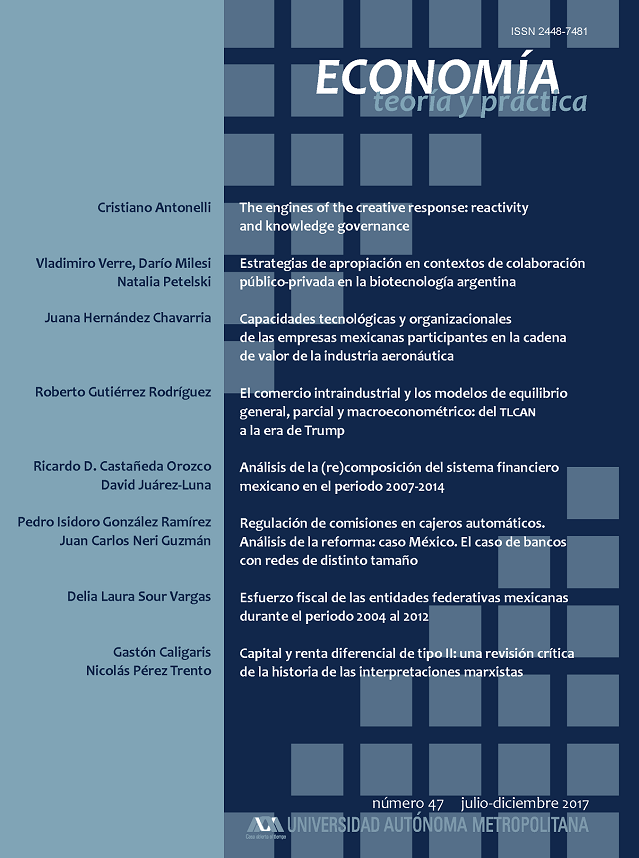Núm. 47 (2017)
Artículos
The Engines of the Creative Response: Reactivity and Knowledge Governance
Publicado
diciembre 1, 2017
Derechos de autor 2017 Economía teoría y práctica

Esta obra está bajo licencia internacional Creative Commons Reconocimiento-CompartirIgual 4.0.
Resumen
The notion of endogenous innovation as the outcome of the creative response of firms to out-of-equilibrium conditions is the cornerstone of the new evolutionary complexity. This essay explores the role of the reactivity of firms to out-of-equilibrium conditions and of knowledge governance in assessing the chances that creative responses actually take place as an alternative to adaptive responses. It implements a systemic frame able to show that: i) the levels of reactivity of firms enhance the research efforts of rims that try and cope with out-of-equilibrium conditions; ii) the actual rates of introduction of innovations and increase of total factor productivity are contingent upon the quality of knowledge governance, and iii) out-of-equilibrium conditions, as well as the amount of knowledge externalities are the endogenous outcome of the creative response.Citas
- Acemoglu, D., Aghion, P., Bursztyn and L., Hémous, D. (2012), “The environment and directed technical change”, American Economic Review, 102, 131-66.
- Aghion, P., Dechezlepretre, A., Hemous, D., Martin, R. and Van Reenen, J. (2016), “Carbon taxes, path dependency, and directed technical change: Evidence from the auto industry”, Journal of Political Economy, 124, 52-104.
- Antonelli, C. (2008), Localized technological change. Towards the economics of complexity, Routledge, London.
- Antonelli, C. (ed.) (2011), Handbook on the economic complexity of technological change, Edward Elgar, Cheltenham.
- Antonelli, C. (2013), “Knowledge governance, pecuniary knowledge externalities and total factor productivity growth”, Economic Development Quarterly, 27, 62-70.
- Antonelli, C. (2015a), “Innovation as a creative response. A reappraisal of the Schumpeterian legacy”, History of Economic Ideas, 23, 99-118.
- Antonelli, C. (2015b), “The dynamics of knowledge governance”, in Antonelli, C., Link, A. (eds.) Handbook on the economics of knowledge, Routledge, London, 232-262.
- Antonelli, C. (2017), Endogenous innovation: The economics of an emergent system property, Edward Elgar, Cheltenham.
- Arrow, K. J. (1962), “Economic welfare and the allocation of resources for invention”, in Nelson, R. R. (ed.), The rate and direction of inventive activity: Economic and social factors. Princeton University Press for n.b.e.r., Princeton, 609-625.
- Arthur, B. (2007), “Complexity and the economy”, in Hanusch, H., Pyka, A. (eds.), Elgar companion to Neo-Schumpeterian economics, Edward Elgar, Cheltenham.
- Arthur, B. (2015), Complexity and the Economy, Oxford, Oxford University Press.
- Arthur, W. B. (2009), The nature of technology. What it is and how it evolves. Free Press, New York.
- Arthur, W. B., Durlauf, S.N. and Lane, D.A. (eds.) (1997), The economy as an evolving complex system II, Addison-Wesley, Redwood City, CA.
- Crépon, B., Duguet, E. and Mairesse, J. (1998), “Research and development, innovation and productivity: An econometric analysis at the firm level”, Economics of Innovation and New Technology, 7 (2), 115-58.
- Dasgupta, P. and Stiglitz, J. (1980), “Industrial structure and the nature of innovative activity”, Economic Journal, 90, 266-293.
- Foster J., Metcalfe J. S. (2012), “Economic emergence: An evolutionary economic perspective”, Journal of Economic Behavior and Organization, 82 (2), 420-432.
- Griliches, Z. (1979), “Issues in assessing the contribution of research and development to productivity growth”, Bell Journal of Economics, 10 (1), 92-116.
- Metcalfe, J. S. (1998), Evolutionary economics and creative destruction, Routledge, London.
- Nelson, R. R. and Winter S. G. (1982), An evolutionary theory of economic change, Cambridge, The Belknap Press of Harvard University Press.
- Newell, R. G., Jaffe, A. B. and Stavins, R. N. (1999), “The induced innovation hypothesis and energy-saving technological change”, Quarterly Journal of Economics, 114, 941-975.
- Ostrom, E. and Hess, C. (eds.) (2006), Understanding knowledge as a commons: From theory to practice, MIT Press, Cambridge.
- Page, S. E. (2011), Diversity and complexity, Princeton University Press, Princeton.
- Porter, M. E. and van der Linde, C. (1995), “Toward a new conception of the environment-competitiveness relationship”, Journal of Economic Perspectives, 9, 97-118.
- Scherer, F. M. (1986), Innovation and growth: Schumpeterian perspectives, MIT Press, Cambridge.
- Schumpeter, J. A. (1911, 1934), The theory of economic development, Harvard University Press, Cambridge.
- Schumpeter, J. A. (1939), Business cycles. A theoretical, historical and statistical analysis of the capitalist process, McGraw-Hill, New York.
- Schumpeter, J. A. (1942), Capitalism socialism and democracy, Harper and Brothers, New York.
- Schumpeter, J. A. (1947), “The creative response in economic history”, Journal of Economic History, 7, 149-159.
- Simon, H. A. (1947), Administrative Behavior: A Study of Decision-Making Processes in Administrative Organization, London, Macmillan.
- Simon, H. A. (1979), “Rational decision making in business organizations”, American Economic Review, 69 (4), 493-513.
- Simon, H. A. (1982), Metaphors of Bounded Rationality: Behavioral Economics and Business Organization, Cambridge, MA, MIT Press.
- Weitzman, M. L. (1996), “Hybridizing growth theory”, American Economic Review, 86, 207-212.


